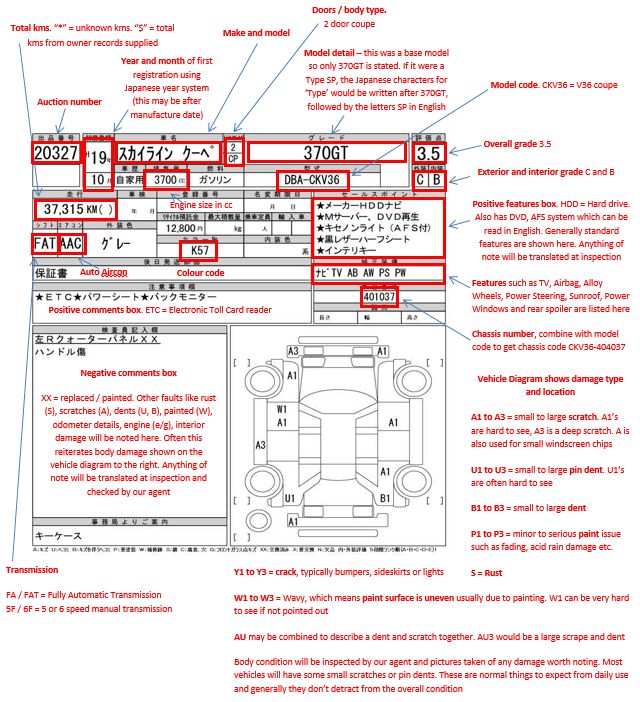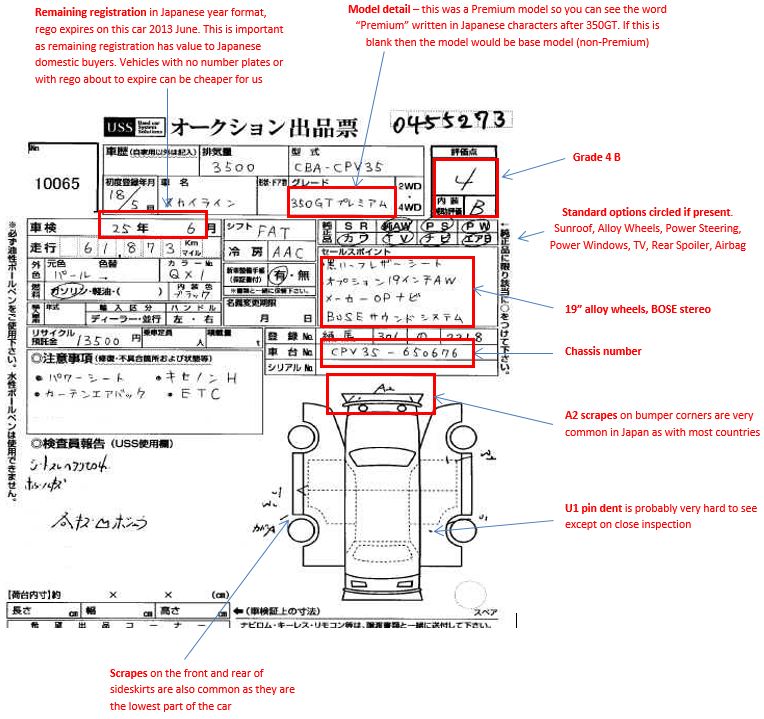How To Read a Japanese Car Auction Sheet
Japanese car auctions offer great cars at good prices, but understanding auction sheets can be tricky. In this guide, we’ll explain everything simply, from grading systems to abbreviations, so you can buy your dream car with confidence. Let’s learn how to read auction sheet.
The Grading System Understanding
✅ S Grade: Brand New Zero Meter
✅ Grade 6: New but with Few kilometers of mileage
✅ Grade 5: As new with no condition faults
✅ Grade 4.5: Very clean, minor paint blemish on one panel
✅ Grade 4: Minor paint blemishes on multiple panels
✅ Grade 3.5: Attention to panel and paint required
✅ Grade 3: Rough overall condition
✅ Grade 2: Serious panel damage, rust, or water damage
✅ Grade 1: Significant performance upgrades or mechanical changes
✅ Grade X: Accidental Vehicle
✅ Grade ★★★ (Triple Star): Also Accidental Vehicle
✅ Grade 99: Accidental or Damaged Vehicle
✅ Grade R: Repaired and replaced parts
✅ Grade RA: Accidental Repaired
✅ No Auction Grade Written: Vehicle is damaged or accidental and not inspected by the auction house
Interior Grades Codes
Interior grades range from A to D, indicating the condition of the vehicle’s interior.
✅ Grade A: As new with no condition faults
✅ Grade B: Very clean and nice
✅ Grade C: Average/clean for age with expected wear and tear
✅ Grade D: Cigarette burns, tears, or other damage, significant wear and tear
Vehicle Equipment Codes
Understanding abbreviations is crucial for comprehending the vehicle’s features and conditions listed on the auction sheet.
✅ AC: Air conditioner
✅ FA/AT: Automatic transmission
✅ F5: Manual (5-speed) transmission
✅ PS: Power steering
✅ SR: Sunroof
✅ AW: Alloy wheels
✅ AAC: Climate control air conditioner
✅ E3: Some dents which are barely visible
Vehicle Marking Codes
✅ U1 to U3: Denotes the size of dents
✅ Y1 to Y3: Denotes the size of tears or damage
✅ W1 to W3: Indicates panel repairs and waviness
✅ S1 to S2: Specifies rust size and severity
✅ X: The panel needs replacement
✅ XX: The panel has been replaced
Learn Vehicle Marking Codes in Details:
✅ A1: Small Scratch
✅ A2: Scratch
✅ A3: Big Scratch
✅ E1: Few Dimples
✅ E2: Several Dimples
✅ E3: Many Dimples
✅ U1: Small Dent
✅ U2: Dent
✅ U3: Big Dent
✅ W1: Negligible Repair Mark/Wave
✅ W2: Repair Mark/Wave
✅ W3: Obvious Repair Mark/Wave
✅ S1: Rust
✅ S2: Heavy Rust
✅ C1: Corrosion
✅ C2: Heavy Corrosion
✅ P: Paint Marked
✅ H: Paint faded
✅ X: Needs to be replaced
✅ XX: Replaced
✅ X1: Small crack on windshield
✅ B1: Small dent with scratch
✅ B2: Dent with scratch
✅ B3: Big dent with scratch
✅ Y1: Small Hole or Crack
✅ Y2: Hole or Crack
✅ Y3: Big Hole or Crack
✅ R: Repaired Crack on Windshield
✅ RX: Repaired Windshield needs replacement
✅ G: Stone chip in glass
Additional Insights from Japanese Auction Sheets
Beyond grades and abbreviations, Japanese auction sheets offer valuable insights into a vehicle’s history and condition. Accident History: Look for codes such as A, 0, R denoting accident damage and repairs. Mileage Confirmation: Symbols like #, $, * indicate unconfirmed mileage, possibly due to odometer swap or age. Exterior/Interior Grades: Detailed grades from 5 to 1 and A to E provide a comprehensive overview of the vehicle’s condition. If you still don’t know how to read auction sheet you can order your auction sheet translation via JP Sheet and get a details overview of your vehicle.

